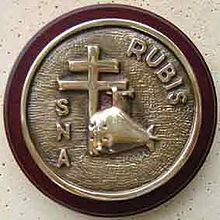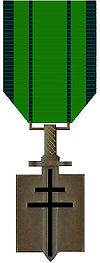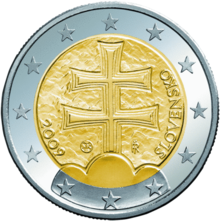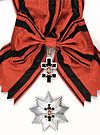- Cross of Lorraine
-
The Cross of Lorraine (French: Croix de Lorraine) is originally a heraldic cross. The two-barred cross consists of a vertical line crossed by two smaller horizontal bars. In the ancient version, both bars were of the same length. In 20th century use it is "graded" with the upper bar being the shortest. The Lorraine name has come to signify several cross variations, including the patriarchal cross with its bars near the top.
Contents
History
The Lorraine cross was carried to the Crusades by the original Knights Templar, granted to them for their use by the Patriarch of Jerusalem.
Hermetic alchemists of the Renaissance used the emblem as a symbol of earth and spirit by combining the square earth cross with the cross of Christ. When drawn symmetrically, it symbolised the hermetic maxim, "As above, so below".
In the Catholic Church, the equal-armed Lorraine Cross denotes the office of Cardinal.
Symbol in France
 The tampion of the Rubis features the Cross of Lorraine in honour of the Free French eponymous submarine.
The tampion of the Rubis features the Cross of Lorraine in honour of the Free French eponymous submarine.
In France, the Cross of Lorraine is the symbol of the Free French Forces of World War II, the liberation of France from Nazi Germany, and Gaullism and includes several variations of a two barred cross. The bars are supposed to be equally spaced[1] as can be seen on most images relating to the Free French Forces, though variations are common.
The Cross of Lorraine is part of the heraldic arms of Lorraine in eastern France. Between 1871 and 1918 (and again between 1940–44), the northern third of Lorraine was annexed to Germany, along with Alsace. During that period the Cross served as a rallying point for French ambitions to recover its "lost" provinces. This historical significance lent it considerable weight as a symbol of French patriotism.
During World War II, Capitaine de corvette Thierry d'Argenlieu suggested the Cross of Lorraine as the symbol of the Free French Forces led by Charles de Gaulle as an answer to the Nazi swastika.
The Cross was displayed on the flags of Free French warships, and the fuselages of Free French aircraft. The medal of the Order of Liberation bears the Cross of Lorraine.
De Gaulle himself is memorialized by a 43 metres (141 ft) high Cross of Lorraine in his home village of Colombey-les-Deux-Églises. The Cross of Lorraine was later adopted by Gaullist political groups such as the Rally for the Republic.
New World
French Jesuit missionaries and settlers to the New World carried the Cross of Lorraine c. 1750-1810. The symbol was said to have helped the missionaries to convert the native peoples they encoutered since the two armed cross resembled existing local imagery.[2]
European heraldry
 The French frigate Aconit, named after the corvette Aconit of the Free French Forces, flies the Cross of Lorraine on her unit flag
The French frigate Aconit, named after the corvette Aconit of the Free French Forces, flies the Cross of Lorraine on her unit flag
The coat of arms of Hungary depicts a double cross, which is often attributed to Byzantine influence as King Béla III of Hungary was raised in the Byzantine Empire in the 12th century, and it was during his rule when the double cross became a symbol of Hungary.
The flag and the coat of arms of Slovakia both include the cross of Lorraine. In Slovakia, the cross of Lorraine as a symbol of Lorraine is considered to have arisen when the Great Moravian king Svatopluk I "passed" it to Zwentibold of Lorraine, the godchild of Svatopluk and son of the emperor Arnulf of Carinthia.[citation needed]
A golden double cross with equal bars, known as the Cross of Jagiellons, was used by Grand Duke of Lithuania and King of Poland Jogaila since his conversion to Christianity in 1386, as a personal insignia and was introduced in the Coat of Arms of Lithuania. Initially, the lower bar of the cross was longer than the upper, since it originates from the Hungarian type of the double cross. It later became the symbol of Jagiellon dynasty and is one of the national symbols of Lithuania, featured in the Order of the Cross of Vytis.
The double cross is one of the national symbols in Belarus. The Belarusian version of the cross symbolises the Cross of Euphrosyne of Polatsk, an important religious artefact. The symbol is supposed to have Byzantine roots and is used by the Belarusian Greek Catholic Church as a symbol uniting Eastern-Byzantine and Western-Latin church traditions. The Belarusian Cross can be found on the traditional coat of arms of Belarus, the Pahonia.
Miscellaneous uses
The cross is used as an emblem by the American Lung Association and related organizations through the world, and as such is familiar from their Christmas Seals program. Its use was suggested in 1902 by Paris physician Gilbert Sersiron as a symbol for the "crusade" against tuberculosis.[3][4]
For its defense of France in World War I, the American 79th Infantry Division was nicknamed the "Cross of Lorraine" Division; its insignia is the cross. In an odd coincidence, the German 79th Infantry Division of World War II used the cross of Lorraine as its insignia because its first attack was in the Lorraine region.
In the television series Magnum, P.I., Thomas Magnum and his Vietnam War comrades were all shown to wear rings that bore the cross of Lorraine.
Ironically, the cross is also used as the symbol of the fascist Norsefire party in the film version of the graphic novel V for Vendetta.
The cross of Lorraine is also used in the SABRE GDS (global distribution system), a computer program used by travel agents. It was also used in the Apollo and Worldspan global distribution systems, however, the latest versions of the Graphical user interfaces for both systems display it as a plus sign, while the latest Graphical user interface for Sabre displays it as a yen symbol.
The "Cross of Lorraine" symbol appears in Unicode as U+2628 (☨). It is similar to the double dagger, U+2021 (‡), which appears in HTML as
‡(‡).The Cross of Lorraine was noted as a symbol of the Free French in the film Casablanca. A ring bearing the Cross was worn by Norwegian underground agent Berger and shown to one of the movies heroes (Victor Laszlo) as proof of loyalty.
Controversial noise musician and one-time LaVeyan Satanist Boyd Rice has also adopted the Cross of Lorraine as a symbol, explicitly because of its hermetic associations. [1]
It has also been used as a symbol for the city Roeselare (black cross) and Ypres(red cross) in Belgium.
Design
The Cross of Lorraine consists of one vertical and two evenly spaced horizontal bars. It is a heraldic cross, used by the Dukes of Lorraine (previously known as the Dukes of Anjou). This cross is related to the Crusader's cross, the standard of Joan of Arc, and the six globes of the Medici family.
See also
- Two barred cross
- Patriarchal cross
- Coat of Arms of Hungary
- Coat of Arms of Slovakia (describes the meaning of the cross and how the patriarchal cross probably became the cross of Lorraine)
- Free French Forces, who used the Cross of Lorraine as their symbol.
- Kotwica, the symbol of the Polish Secret State
References
- ^ Cross of Lorraine, CA: BCY, http://www.freemasonry.bcy.ca/symbolism/cross/cross_lorraine.html.
- ^ Charlotte Gray 'The Museum Called Canada: 25 Rooms of Wonder' Random House, 2004
- ^ "The Cross of Lorraine – a symbol of the anti-TB "crusade"". TB Alert. http://www.tbalert.org/about/cross.php. Retrieved 2006-11-18.
- ^ "History of the Double-Barred Cross". Alberta Lung Association. Archived from the original on 2008-01-13. http://web.archive.org/web/20080113123528/http://www.ab.lung.ca/about_us/cross_lorraine.php. Retrieved 2006-11-18.
External links
Categories:- Cross symbols
- Lorraine
Wikimedia Foundation. 2010.






